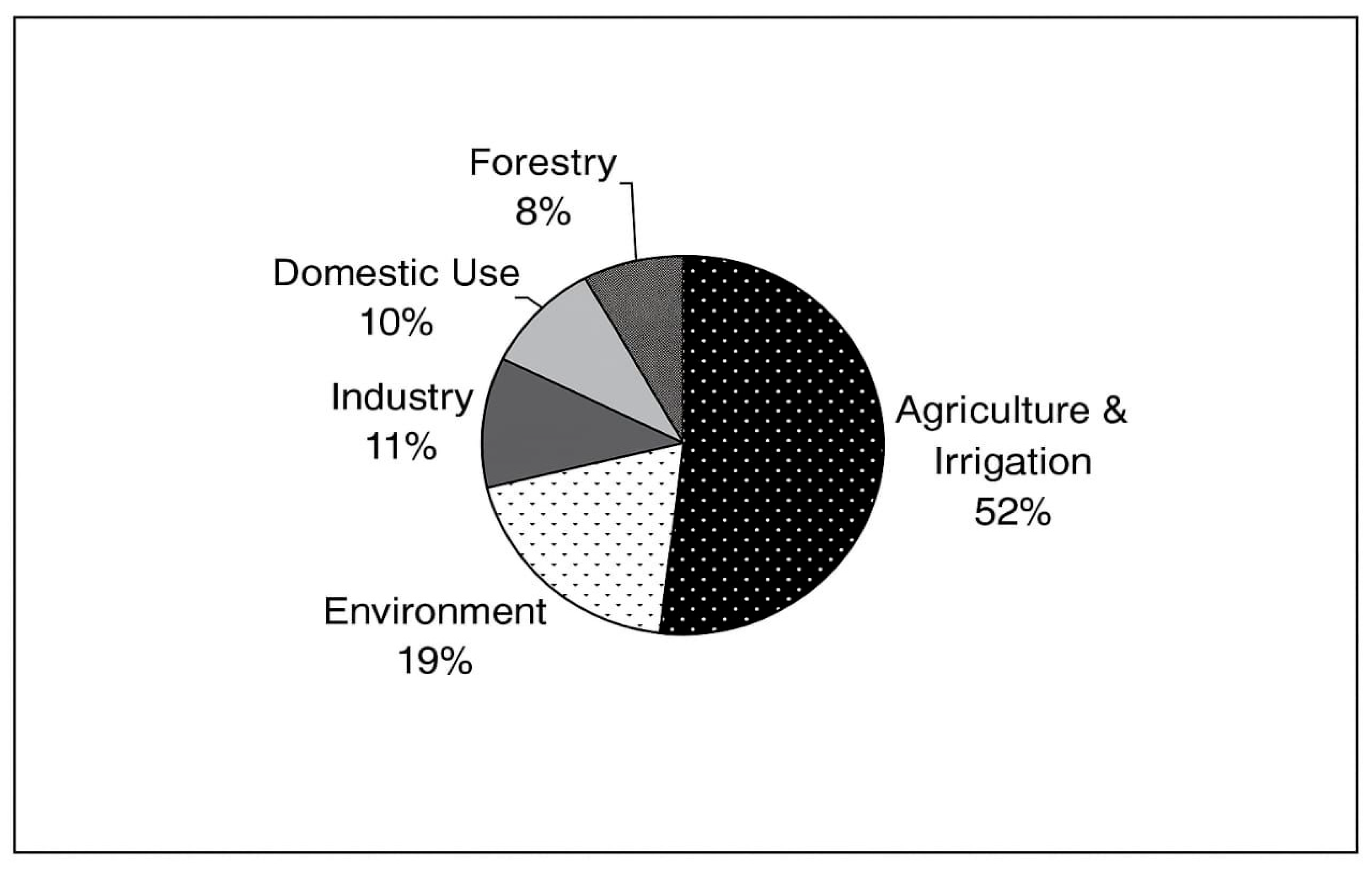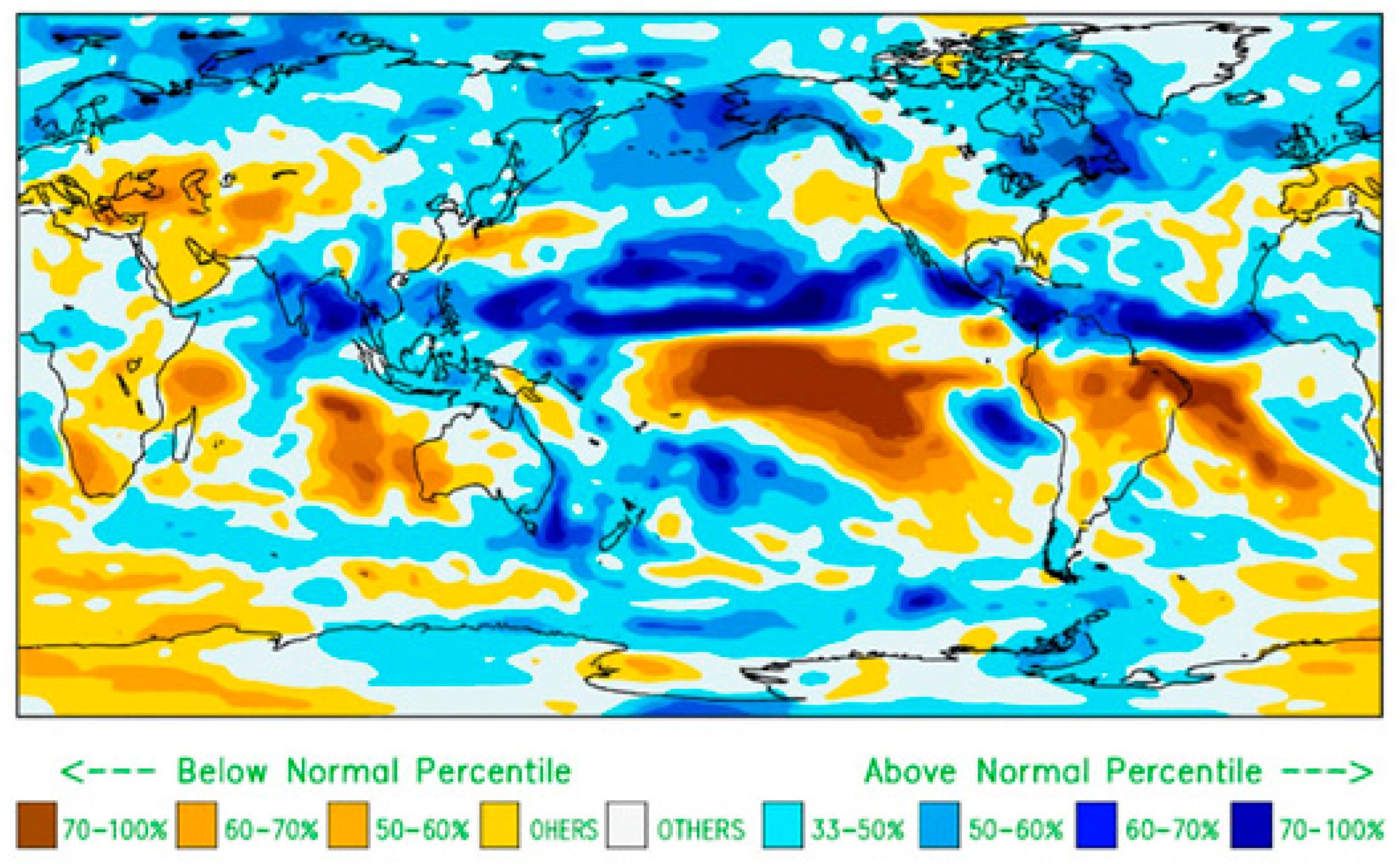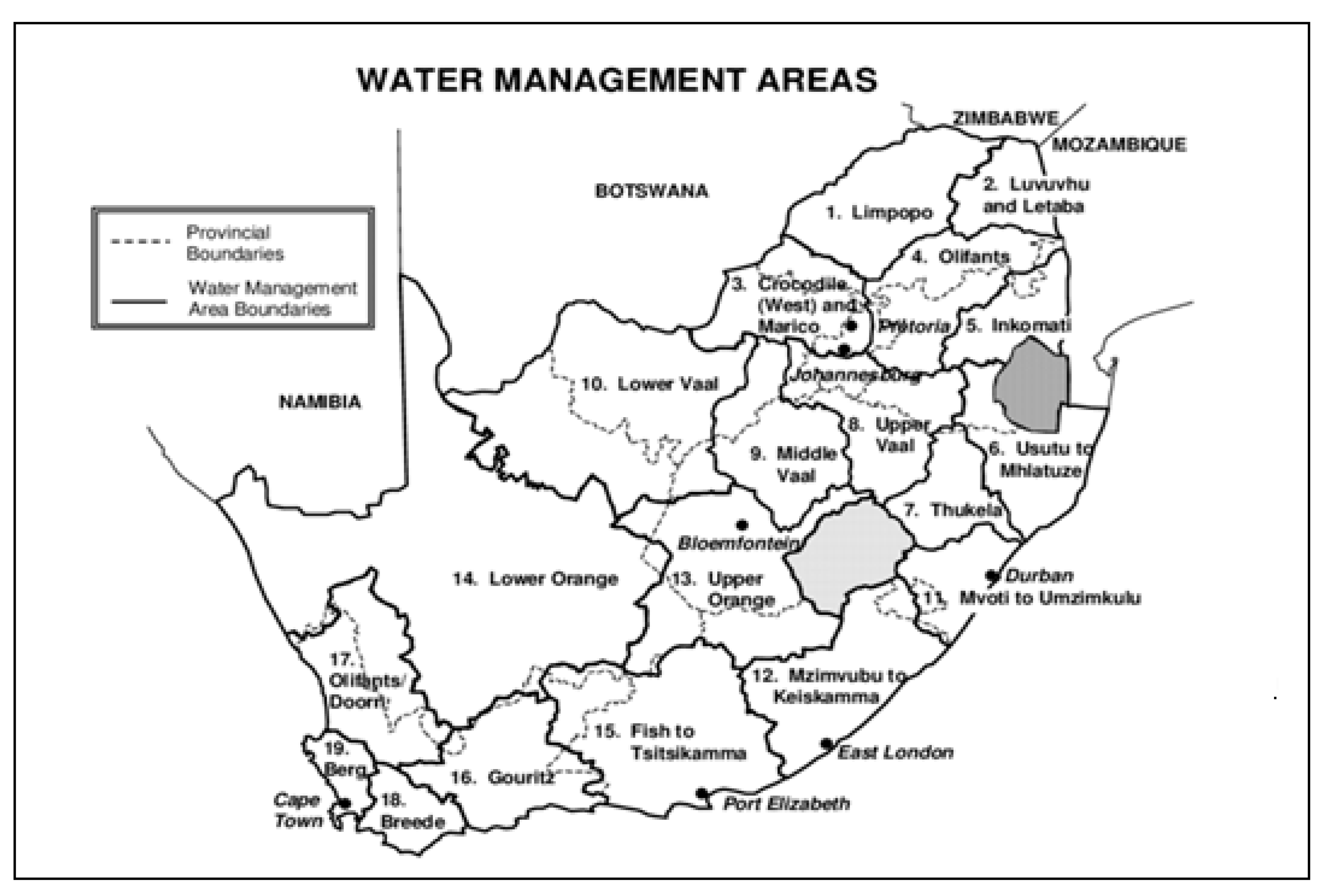Management of Water Resources in South Africa: A Systematic Review
Abstract
1. Introduction
2. Methods
2.1. Data Collection
2.2. Data Extraction
- ➢
- Only studies published in the English language were included
- ➢
- Only studies relevant to South Africa were selected
- ➢
- Only studies that address aspects of WRM in were selected
- ➢
- Geographical irrelevance: research not focused on South Africa or lacking significant relevance to the South African context was excluded to ensure the review remains regionally grounded.
- ➢
- Non-management focus: studies that did not address aspects of water resource management were omitted.
- ➢
- Inadequate methodological rigor: articles lacking a clear methodology, including anecdotal reports, editorials, or opinion pieces, were excluded to maintain the scientific integrity of the review.
- ➢
- Language: only studies published in English were included, due to limitations in translation capacity and to ensure accurate interpretation of findings.
- ➢
- Redundancy: duplicates or studies presenting identical data without additional insights were excluded to avoid redundancy.
3. Dimensions of Analysis
3.1. Stakeholders’ Participation and South Africa’s Current Water Management
3.2. South Africa’s Water Resource Scarcity and Unequal Distribution
3.3. Water Usage and Allocation in South Africa

3.4. Climate Change Effects on Water Availability
3.5. Urbanization and Population Growth
3.6. Economic Aspects
3.7. Water Quality and Biostability

3.8. Technological Innovations
4. Challenges in South Africa’s WRM
- a.
- Funding and resource allocation
- b.
- Policy implementation gaps
- c.
- Education and capacity building
5. Conclusions
6. Policy Recommendations
- ➢
- A key priority should be expanding community participation in decision-making processes, ensuring that the voices of historically marginalized groups are heard and considered in water planning and governance.
- ➢
- Equally important should be investment in educational programs and capacity-building initiatives to equip individuals and institutions with the skills and knowledge needed for sustainable WRM.
- ➢
- Technological advancements must be leveraged to improve water quality monitoring, data collection, and real-time management, enabling more responsive and informed decision-making.
Author Contributions
Funding
Institutional Review Board Statement
Informed Consent Statement
Data Availability Statement
Acknowledgments
Conflicts of Interest
References
- Khofi, L.; Manderson, L.; Reid, M.; Moyer, E. A review of the social and local dynamic in South Africa’s ware energy food nexus. J. Environ. Manag. 2025, 380, 124938. [Google Scholar] [CrossRef]
- Nkosi, M.; Mathivha, F.I.; Odiyo, J.O. Impact of land management of water resources a south African’s context. Sustainability 2021, 13, 701. [Google Scholar] [CrossRef]
- Afuye, G.A.; Majahana, J.M.; Kalumba, A.M.; Zhou, L.; Mazingo, S.P. Drought Disasters, Vulnerability, Severity, Preparedness and Response to the Water Sector: A Comprehensive Model Approach for Water Governance and Policy in South Africa. Prog. Disaster Sci. 2025, 26, 100417. [Google Scholar]
- Richards, K.A.; Mulala, D.S. Overcoming systematic and institutional challenges in policy implementation in South Africa’s water sector. Sustain. Water Resour. Manag. 2024, 10, 69. [Google Scholar]
- Makanda, K.; Nzama, S.; Kanyerere, T. Assessing the role of water resources protection practice for sustainable water resources management: A Review. Water 2022, 14, 3153. [Google Scholar] [CrossRef]
- Kuddus, M.A.; Tynan, E.; McBryde, E. Urbanization: A problem for the rich and the poor? Public Health Rev. 2020, 41, 1. [Google Scholar] [CrossRef]
- Yu, P.; Wei, Y.; Ma, L.; Wang, B.; Yung, E.; Chem, Y. Urbanization and the urban critical zone. Earth Crit. Zone 2024, 1, 100011. [Google Scholar] [CrossRef]
- Turok, I.; Barel-Saladin, J. Is urbanisation in South Africa on a sustainable trajectory? Dev. S. Afr. 2014, 31, 675–691. [Google Scholar] [CrossRef]
- Adeyeye, K.; Gibbert, J.; Chakwizira, J. Water marginality in rural and peri-urban communities. J. Clean. Prod. 2020, 273, 122594. [Google Scholar] [CrossRef]
- Mthiyane, D.B.; Wissink, H.; Chiwawa, N. The impact of rural-urban migration in South Africa: A case of KwaDukuza municipality. J. Local Gov. Res. Innov. 2022, 3, a56. [Google Scholar] [CrossRef]
- Kaziboni, A. Exclusion and invented water scarcity: A historical perspective from colonialism to apartheid in South Africa. Water Hist. 2024, 16, 45–63. [Google Scholar] [CrossRef]
- Jegede, A.O.; Shikwambane, P. Water “Apartheid” and the significance of human rights principles of affirmative action in South Africa. Water 2021, 13, 1104. [Google Scholar] [CrossRef]
- Tarantino, R. South African Rights and Legacies of Apartheid. In BSV Honors Program Theses and Projects; Bridgewater State University: Bridgewater, MA, USA, 2019; Item 402. [Google Scholar]
- Tewari, D.D. A detailed analysis of evolution of water rights in South Africa: An account of three and a half centuries from 1652 AD to present. Water SA 2009, 35, 693–710. [Google Scholar] [CrossRef]
- Bablin, E. Foundation and change of water Inequality in South Africa: South African Water History. In The Proceedings of Great Day 2020; Milne Library: New York, NY, USA, 2021. [Google Scholar]
- Nightingale, A. A guide to systematic literature reviews. Surgery 2009, 27, 381–384. [Google Scholar] [CrossRef]
- Salisbury, L. Web of Science and Scopus: A comparative review of content and searching capabilities. Charlest. Advis. 2009, 1, 5–18. [Google Scholar]
- Department of Water and Sanitation. Review of the National Water Resources Strategy. Gov. Gaz. 2022, 3, 2327. [Google Scholar]
- Department of Water and Sanitation. Update of National and Sectoral Water Conservation and Water Demand Management Strategies 2023; WP 11390; Department of Water and Sanitation: Pretoria, South Africa, 2023. [Google Scholar]
- Water Research Commission. A Comparison of the South African Approach to Water Resources Management and Planning with International Countries; WRC Report No. KU 341/15; Water Research Commission: Pretoria, South Africa, 2016. [Google Scholar]
- Germanie, V.; Van der Walt, K. South Africa’s Water Crisis—An Interdisciplinary Approach. Natl. Water Sanit. Master Plan 2018, 58, 483–500. [Google Scholar]
- Igamba, J. Water Crisis in South Africa. Greenpeace International [Internet]. 2022. Available online: https://www.greenpeace.org/africa/en/blogs/51757/water-crisis-in-south-africa/. (accessed on 20 June 2025).
- Water Research Commission. The Water Energy Nexus in the Context of Climate Change: Investigating Trade-Offs Between Water Use Efficiency and Renewable Energy Options for South Africa; WRC Report Number 2239/1/15; Water Research Commission: Pretoria, South Africa, 2016. [Google Scholar]
- Adom, R.K.; Simatele, M.D.; Reid, M. Assessing the social and economic implications on water security in the Nelson Mandela Bay Metropolitan Municipality, Eastern Cape of South Africa. J. Water Health 2023, 21, 939–955. [Google Scholar] [CrossRef]
- Msibi, M.I.; Dlamini, P.Z. Water Allocation Reform in South Africa: History, Processes and Prospects for Future Implementation; WRC Report No. 1855/1/11; Water Research Commission: Pretoria, South Africa, 2011. [Google Scholar]
- Jack, O.; Marin, C.; Tilak, G.; Laura, B.M. A systematic literature review of sustainable water management in South Africa. Sustain. Water Resour. Manag. 2023, 10, 162. [Google Scholar]
- Schreiner, B. View point: Why has the South African’s National Water Act been so difficult to implement? Water Altern. 2013, 6, 239–245. [Google Scholar]
- Hydrosoft Institute. Decolonising Water Access and Allocation: A Renewed to Address Persistent Inequalities in the Water Sector; WRC Report No 2858/1/21; Water Research Commission: Pretoria, South Africa, 2021. [Google Scholar]
- Francis, R. Water Justice in South Africa: Natural Resources Policy at the Intersection of Human Rights, Economics, and Political Power; Bepress Legal Repository: Berkeley, CA, USA, 2025. [Google Scholar]
- Molobela, I.P.; Sinha, P. Management of water resources in South Africa: A review. Afr. J. Environ. Sci. Technol. 2011, 5, 993–1002. [Google Scholar] [CrossRef]
- Adom, R.K.; Simatele, M.D.; Reid, M. The threats of climate change on water and food security in South Africa. Am. J. Environ. Clim. 2022, 1, 73–91. [Google Scholar] [CrossRef]
- Edokpayi, J.N.; Makungu, R.; Mathivha, F.; Nkuna, T.R. Influence of global clime change on water resources in South Africa: Toward an adaptive management approach. In Water Conservation and Wastewater Treatment in BRICS Nations; Elsevier: Amsterdam, The Netherlands, 2020; pp. 83–115. [Google Scholar]
- Carden, K.; Armitage, N.P. Assessing urban water sustainability in South Africa-not just performance measurement. Water SA 2013, 39, 345–350. [Google Scholar] [CrossRef]
- Chitong, H. Urbanization and the water challenges in Africa: Mapping out orders of water scarcity. Afr. Stud. 2020, 79, 1–20. [Google Scholar]
- Turok, I. South Africa’s tortured urbanization and the complications of reconstruction. In Urban Growth in Emerging Economics; Routledge: London, UK, 2014; Volume 1, pp. 143–190. [Google Scholar]
- Cole, M.J.; Bailey, R.; Cullis, J.; New, M.G. Spatial inequality in water access and water use in South Africa. Water Policy 2017, 20, 2017111. [Google Scholar] [CrossRef]
- Mpongwana, Z.; Shumba, K.; Bracking, S. Reflections on rural household water insecurity: Evidence from Goboti and Khubui in the Eastern Cape and Limpopo provinces, South Africa. Afr. J. Inter/Multidiscip. Stud. 2022, 4, 217–233. [Google Scholar] [CrossRef]
- Tshona, S.S.; Lungisa, S.; Mgweba, L. Thirsting for solutions: Unpacking inadequate water provision in rural communities. Afr. Public Serv. Deliv. Perform. Rev. 2024, 13, a873. [Google Scholar] [CrossRef]
- Dinar, A. Challenge to water resources management: The role of Economic and modelling approaches. Water 2024, 16, 610. [Google Scholar] [CrossRef]
- Bwapwa, J.K. Review on main issues causing deterioration of water quality and water scarcity: Case study of South Africa. Environ. Manag. Sustain. Dev. 2018, 7, 14. [Google Scholar] [CrossRef]
- Prest, E.I.; Hammes, F.; Mark van Loosdrecht, C.M.; Vrouwenvelder, J.S. Biological stability of drinking water: Controlling factors, methods, and challenges. Front. Microbiol. 2016, 7, 45. [Google Scholar] [CrossRef]
- Okello, C.; Githoora, Y.W.; Sithole, S.; Owuor, M. Nature-based solutions for water resource management in Africa’s arid and semi-arid lands (ASALs): A systematic review of existing interventions. Nat.-Base Solut. 2025, 6, 100172. [Google Scholar] [CrossRef]
- Onyena, A.P.; Sam, K. The blue revolution: Sustainable water management for a thirsty world. Discov. Sustain. 2025, 6, 63. [Google Scholar] [CrossRef]
- Takhumova, O.; Goncharova, M. Innovative approaches to water resources management in achieving sustainable development goals. E35 Web Conf. 2025, 614, 04019. [Google Scholar] [CrossRef]
- Patience, M.; Stuart, W.; Deborah, C.; Milanthi, J.; Javier, M.S.; Chris, D. In water quality and management in Africa: Toward developing an African water quality program (AWAQ). Int. Water Manag. Inst. (IWMI) 2024, 208, 52. [Google Scholar]
- Boularbah, S.; Elkhoumso, W.; Bourziza, R. Treated waste water reuse in Agriculture: An overview. E35 Web Conf. 2024, 429, 05002. [Google Scholar] [CrossRef]
- Malaza, M.; Mabunda, A. Challenges of integrated water resources management in the Western Cape Province, South Africa. J. Water Resour. Ocean Sci. 2019, 2, 9. [Google Scholar] [CrossRef]
- Ruiters, C.; Echendu, J.A. Economic costs and investment challenges of water infrastructure in South Africa. Infrastruct. Asset Manag. 2022, 9, 194–206. [Google Scholar] [CrossRef]
- Ruiters, C. Funding models for financing water infrastructure in South Africa: Framework and critical analysis of alternatives. Water SA 2013, 39, 313–326. [Google Scholar] [CrossRef][Green Version]
- Scopetsa, T. Challenges facing the implementation of public policies in South Africa since the dawn of democracy. Educor Multidiscip. J. 2020, 4, 141. [Google Scholar][Green Version]
- Mackay, H.M.; Rogers, K.H.; Roux, D.J. Implementing the South African water policy: Holding the vision while exploring an uncharted mountain. Water SA 2004, 29, 4. [Google Scholar] [CrossRef]
- Adam, R.K.; Simatele, M.D. Analysis of public policies and programmes toward water security in post policies and programmes towards water security in post-apartheid South Africa. Water Policy 2021, 23, 503–520. [Google Scholar] [CrossRef]
- Mpu, Y.; Adu, E.O. The challenges of inclusive education and its implementation in schools: The South African perspectives. Perspect. Educ. 2021, 39, 225–238. [Google Scholar] [CrossRef]
- Donolwe, D.; Bomman, J. The challenges of realising inclusive education in South Africa. South Afr. J. Educ. 2014, 34, 2076–3433. [Google Scholar] [CrossRef]
- Jardinez, M.J. The advantages and challenges of inclusive education: Striving for equity in the classroom. J. Educ. 2024, 12, 57–65. [Google Scholar] [CrossRef]
- Merci, M. Empowering communities for sustainable water management: Insights from Justdiggit and the Paani foundation. E53 Web Conf. 2024, 550, 01042. [Google Scholar]
- Bazaanah, P.; Nthama, M.L. Community participation in water and sanitation service delivery: An empirical case of Mantsopa Municipality, South Africa. Big Data Water Resour. Eng. (BDWRE) 2023, 4, 16–26. [Google Scholar] [CrossRef]
- Joshua, R.; Nokulunga, B.; Hulisani, M.; Mirrander, N.; Judy, R. National State of Water Report; Department of Water and Sanitation, SA: Pretoria, South Africa, 2023. [Google Scholar]
- Department of Water and Sanitation. South Africa. National Water Resource Strategy III; Department of Water and Sanitation: Pretoria, South Africa, 2023. [Google Scholar]
- Savenije, H.H.G. Water Resources Management Concepts and Tools; Lecture Notes; WERM011/96; International Institute for Infrastructure, Hydraulic and Environmental Engineering: Delft, The Netherlands, 1996. [Google Scholar]

Disclaimer/Publisher’s Note: The statements, opinions and data contained in all publications are solely those of the individual author(s) and contributor(s) and not of MDPI and/or the editor(s). MDPI and/or the editor(s) disclaim responsibility for any injury to people or property resulting from any ideas, methods, instructions or products referred to in the content. |
© 2025 by the authors. Licensee MDPI, Basel, Switzerland. This article is an open access article distributed under the terms and conditions of the Creative Commons Attribution (CC BY) license (https://creativecommons.org/licenses/by/4.0/).
Share and Cite
Omalanga, L.S.; Onyari, E.K. Management of Water Resources in South Africa: A Systematic Review. Limnol. Rev. 2025, 25, 50. https://doi.org/10.3390/limnolrev25040050
Omalanga LS, Onyari EK. Management of Water Resources in South Africa: A Systematic Review. Limnological Review. 2025; 25(4):50. https://doi.org/10.3390/limnolrev25040050
Chicago/Turabian StyleOmalanga, Landry S., and Ednah K. Onyari. 2025. "Management of Water Resources in South Africa: A Systematic Review" Limnological Review 25, no. 4: 50. https://doi.org/10.3390/limnolrev25040050
APA StyleOmalanga, L. S., & Onyari, E. K. (2025). Management of Water Resources in South Africa: A Systematic Review. Limnological Review, 25(4), 50. https://doi.org/10.3390/limnolrev25040050





